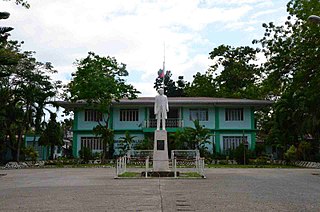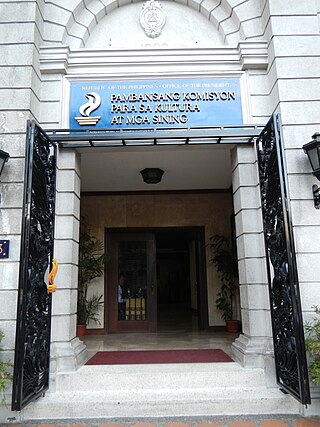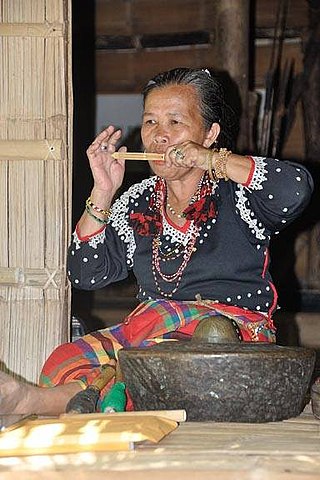Related Research Articles

Sarangani, officially the Province of Sarangani, is a province in the Philippines located in the Soccsksargen region. Its capital is Alabel. With a 230-kilometre (140 mi) coastline along the Sarangani Bay and Celebes Sea, the province is at the southernmost tip of Mindanao island, and borders South Cotabato and Davao del Sur to the north, Davao Occidental to the east, and the Celebes Sea to the south.

Alabel, officially the Municipality of Alabel, is a 1st class municipality and capital of the province of Sarangani, Philippines. According to the 2020 census, it has a population of 88,294 people.

Malapatan, officially the Municipality of Malapatan, is a 1st class municipality in the province of Sarangani, Philippines. According to the 2020 census, it has a population of 80,741 people.

The National Commission for Culture and the Arts of the Philippines is the official government agency for culture in the Philippines. It is the overall policy making body, coordinating, and grants giving agency for the preservation, development and promotion of Philippine arts and culture; an executing agency for the policies it formulates; and task to administering the National Endowment Fund for Culture and the Arts (NEFCA) – fund exclusively for the implementation of culture and arts programs and projects.
Indonesians in the Philippines consist of expatriates and immigrants from Indonesia residing in the Philippines, and their descendants. Among them were many formerly stateless people, legally called Persons of Indonesian descent (PID), whom the United Nations and the governments of the two countries helped to acquire citizenship.
The legislative districts of South Cotabato are the representations of the province of South Cotabato and the urbanized city of General Santos in the various national legislatures of the Philippines. The province is currently represented in the lower house of the Congress of the Philippines through its first and second congressional districts.
The arts in the Philippines reflect a range of artistic influences on the country's culture, including indigenous art. Philippine art consists of two branches: traditional and non-traditional art. Each branch is divided into categories and subcategories.

The Blaan people, are one of the Indigenous peoples of Southern Mindanao in the Philippines. Their name could have derived from "bla" meaning "opponent" and the suffix "an" meaning "people". According to a 2021 genetic study, the Blaan people also have Papuan admixture.

The National Living Treasures Award, alternatively known as the Gawad sa Manlilikha ng Bayan, is conferred to a person or group of artists recognized by the Government of the Philippines for their contributions to the country's intangible cultural heritage. A recipient of the award, a National Living Treasure or Manlilikha ng Bayan is "a Filipino citizen or group of Filipino citizens engaged in any traditional art uniquely Filipino, whose distinctive skills have reached such a high level of technical and artistic excellence and have been passed on to and widely practiced by the present generations in their community with the same degree of technical and artistic competence."
Alabel National Science High School is the Regional Science High School for Region XII situated in Alabel, Sarangani, Philippines. It envisions itself as a regional center of excellence in science and mathematics education at the secondary level that shall develop potential leaders in science and other related fields. It seeks to develop responsible and morally upright science-oriented leaders through relevant and globally competitive science and mathematics education programs.
Intangible cultural heritage (ICH) includes traditions and living expressions that are passed down from generation to generation within a particular community.
Lang Dulay was a Filipino traditional weaver who was a recipient of the National Living Treasures Award.

Salinta Monon was a Filipino textile weaver who was the one of two recipients of the National Living Treasures Award in 1998. She was known for her Bagobo-Tagabawa textiles and was known as the "last Bagobo weaver".
Federico Caballero is a Filipino chanter of Philippine epic poetry. Caballero is a recipient of the National Living Treasures Award.
Fu Yabing Masalon Dulo, commonly referred to as Fu Yabing, was a Filipino textile master weaver and dyer, credited with preserving the Blaan traditional mabal tabih art of ikat weaving and dyeing. At the time of her death, she was one of only two surviving master designers of the mabal tabih art of the indigenous Blaan people of southern Mindanao in the Philippines.
Ambalang Ausalin was a Filipino master weaver from the city of Lamitan, Basilan.
Darhata Sawabi was a Filipino weaver from Parang, Sulu known for pis syabit, a traditional Tausūg cloth tapestry worn as a head covering by the people of Jolo. She is a recipient of the National Living Treasures Award, having given the distinction in 2004. Pis refers to the geometric pattern that is said to be derived from the Indic mandala, and siyabit stands for the hook and technique.
Haja Amina Appi was a Filipino master mat weaver and teacher from the Sama indigenous people of Ungos Matata, Tandubas, Tawi-Tawi. She was credited for creating colorful pandan mats with complex geometric patterns. Her creations were acclaimed for their precise sense of design, proportion and symmetry, and sensitivity to color.
Teofilo Garcia is a Filipino hatter who is regarded as a National Living Treasure in the Philippines for making tabungaw hats, a type of Ilocano headwear.
Magdalena Gamayo is a Filipino weaver who is a lead-practitioner of the Ilocano tradition of pinagabel.
References
- 1 2 Pastor Roces, Marian. "National Living Treasures: Estelita Bantilan". National Commission for Culture and the Arts. Archived from the original on February 25, 2022. Retrieved December 5, 2020.
- ↑ Sembrano, Edgar Allan (2019-06-16). "National living treasure Estelita Bantilan, NCCA inaugurate weaving center in Sarangani". Inquirer. Retrieved 2020-12-05.